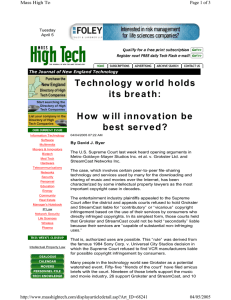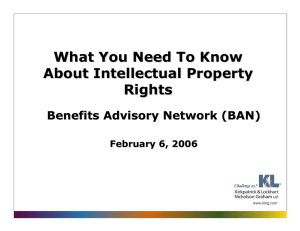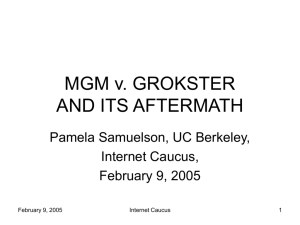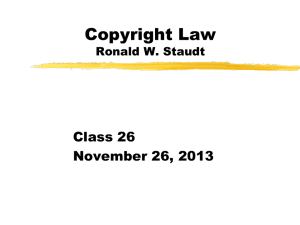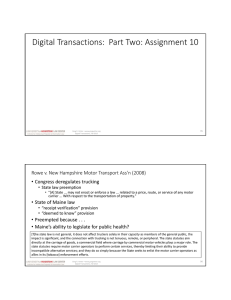Copyrights In Grokster The Supreme Court Reinstates Infringement
advertisement
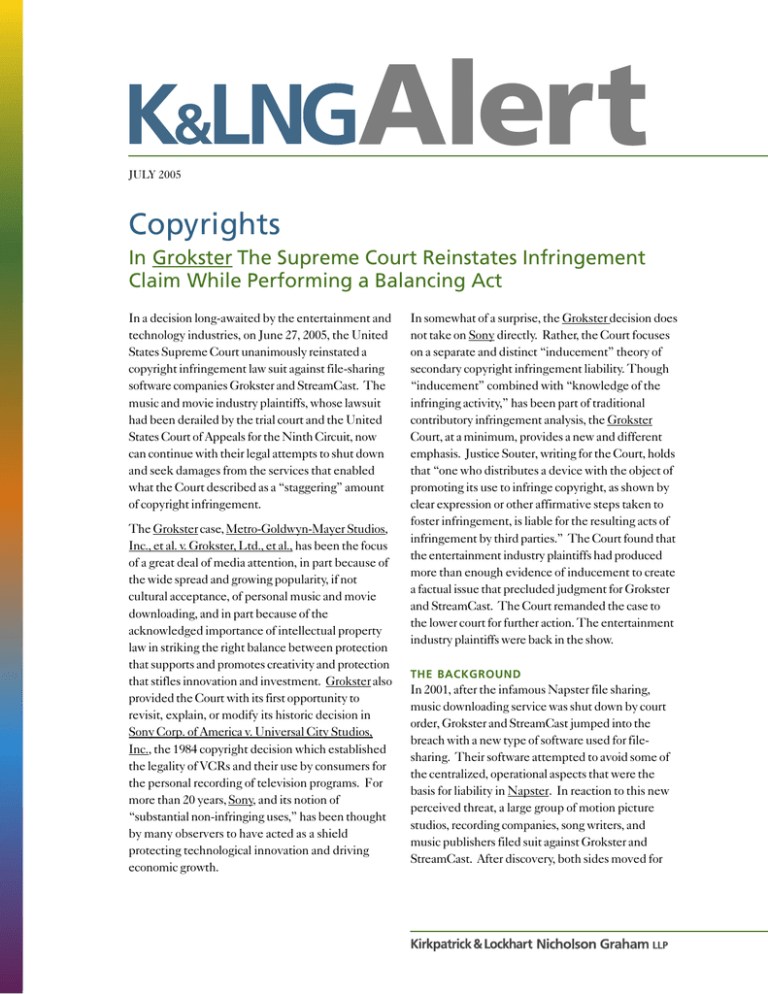
JULY 2005 Copyrights In Grokster The Supreme Court Reinstates Infringement Claim While Performing a Balancing Act In a decision long-awaited by the entertainment and technology industries, on June 27, 2005, the United States Supreme Court unanimously reinstated a copyright infringement law suit against file-sharing software companies Grokster and StreamCast. The music and movie industry plaintiffs, whose lawsuit had been derailed by the trial court and the United States Court of Appeals for the Ninth Circuit, now can continue with their legal attempts to shut down and seek damages from the services that enabled what the Court described as a “staggering” amount of copyright infringement. The Grokster case, Metro-Goldwyn-Mayer Studios, Inc., et al. v. Grokster, Ltd., et al., has been the focus of a great deal of media attention, in part because of the wide spread and growing popularity, if not cultural acceptance, of personal music and movie downloading, and in part because of the acknowledged importance of intellectual property law in striking the right balance between protection that supports and promotes creativity and protection that stifles innovation and investment. Grokster also provided the Court with its first opportunity to revisit, explain, or modify its historic decision in Sony Corp. of America v. Universal City Studios, Inc., the 1984 copyright decision which established the legality of VCRs and their use by consumers for the personal recording of television programs. For more than 20 years, Sony, and its notion of “substantial non-infringing uses,” has been thought by many observers to have acted as a shield protecting technological innovation and driving economic growth. In somewhat of a surprise, the Grokster decision does not take on Sony directly. Rather, the Court focuses on a separate and distinct “inducement” theory of secondary copyright infringement liability. Though “inducement” combined with “knowledge of the infringing activity,” has been part of traditional contributory infringement analysis, the Grokster Court, at a minimum, provides a new and different emphasis. Justice Souter, writing for the Court, holds that “one who distributes a device with the object of promoting its use to infringe copyright, as shown by clear expression or other affirmative steps taken to foster infringement, is liable for the resulting acts of infringement by third parties.” The Court found that the entertainment industry plaintiffs had produced more than enough evidence of inducement to create a factual issue that precluded judgment for Grokster and StreamCast. The Court remanded the case to the lower court for further action. The entertainment industry plaintiffs were back in the show. THE BACKGROUND In 2001, after the infamous Napster file sharing, music downloading service was shut down by court order, Grokster and StreamCast jumped into the breach with a new type of software used for filesharing. Their software attempted to avoid some of the centralized, operational aspects that were the basis for liability in Napster. In reaction to this new perceived threat, a large group of motion picture studios, recording companies, song writers, and music publishers filed suit against Grokster and StreamCast. After discovery, both sides moved for summary judgment. The trial court held that the users of the file-sharing software, i.e., the public, directly infringed the plaintiffs’ copyrights, but Grokster and StreamCast were granted summary judgment as to secondary copyright infringement. It appeared that the changes in the technology made a difference under the law. The trial court ruled that Grokster and StreamCast could not be liable because the de-centralized network of users created by their software did not allow Grokster and StreamCast to have the requisite actual knowledge of specific acts of infringement. Without that knowledge, they had not violated the law. The entertainment industry appealed, but in a decision that surprised many, the Ninth Circuit Court of Appeals affirmed the dismissal of the case based on its reading of Sony. The appeals court held that there could be no secondary copyright infringement liability for Grokster and StreamCast because the software was “a commercial product capable of substantial noninfringing uses,” and they had no actual knowledge of specific acts of infringement that they had failed to stop. This rule, according to the appeals court, immunized Grokster and StreamCast, even though there was strong evidence that the overwhelming percentage of use (the plaintiffs said no less than 90%) was by users committing massive infringement, perhaps numbering in the billions of illegally downloaded files. THE SUPREME COURT AND THE HOOPLA The Supreme Court accepted the entertainment industry’s request for review. The case attracted great interest in the world of entertainment, technology, and business. More than 50 “friends of the Court” filed briefs in the case. The amici represented an incredibly diverse group, including Intel, the National Venture Capital Association, The American Civil Liberties Union, The Office of the Commissioner of Major League Baseball, the Business Software Alliance, numerous law school professors, the Consumer Electronics Association, the American Intellectual Property Law Association, and the Christian Coalition. Debate raged in the court filings, in the press, and in the on-line world. “Innovation,” both sides argued, had to be nurtured. 2 JULY 2005 The entertainment industry argued that real intellectual property protection that allows hard work and creativity to be rewarded was the only way to foster innovation. Grokster and StreamCast, and their supporters, argued that overbroad copyright protection could stifle technological advance and scare off investment in the technology sector. THE SUPREME COURT’S BALANCING ACT In its decision reinstating the case against Grokster and StreamCast, the Supreme Court showed a keen awareness of the balancing act that is at the heart of much intellectual property protection: how much protection is enough, how much protection is too much? The Court itself noted the tension between the value of “supporting creative pursuits through copyright protection and promoting innovation in new communication technologies by limiting the incidence of liability for copyright infringement.” Though the Court reversed the Ninth Circuit, it did so by focusing on the conduct of Grokster and StreamCast, not on the nature of the technology itself. “One infringes contributorily,” the Court stated, “by intentionally inducing or encouraging direct infringement.” By holding that evidence of the defendants’ acts precluded summary judgment on inducement, the Court was able to provide legal protection against a powerful engine for infringement, while at least theoretically, not dampening future technological advances. The Supreme Court did not need to directly explain the meaning of Sony; it nevertheless noted that the Ninth Circuit Court of Appeals misunderstood and misapplied Sony, reading the “substantial noninfringing use” language as a broad immunization from any secondary liability, except in very limited circumstances. According to the Court, the Ninth Circuit Court of Appeals failed to appreciate that Sony “did not displace other theories of liability,” like inducement. The test in Sony is applicable to circumstances in which liability is based solely on the distribution of a product that had both lawful and unlawful purposes, not to instances, such as in Grokster, in which the “evidence goes beyond a product’s characteristics or the knowledge that it may be put to infringing uses, and shows statements or actions directed to promoting infringement….” Sony KIRKPATRICK & LOCKHART NICHOLSON GRAHAM LLP was not reversed or revised, and its perceived salutary effect for technology companies was not disturbed. In short, at least for the moment, the Court limited the reach of Sony without eroding its core effect. In fact, the two concurrences, each supported by three justices, attest to the ongoing vitality of Sony, as the opinions debate with each other how the “substantial non-infringing uses” test might be applied. THE INDUCEMENT RULE The Court elaborates on what it calls the “inducement rule.” Secondary liability may be based on the distribution of a device, which is promoted to infringe copyrights, in a manner that is clear and affirmative. “[M]ere knowledge of infringing potential or of actual infringing uses” is not enough to have liability attach to a distributor under this rule. Only “purposeful, culpable expression and conduct” can lead to liability. In this way, what the Court characterizes as “legitimate commerce” and “innovation having a lawful promise” will not be affected at all. Of course, identifying these acts which turn a “legitimate” commercial enterprise into an unlawful infringer may not be simple. The Court identified several “active steps to encourage infringement” taken by Grokster and StreamCast: ■ The promotion of the services to users and advertisers as successors to Napster ■ The derivation of the Grokster name from Napster ■ The promotion of an expanded body of copyright protected music to users ■ The adoption of a business model based on giving away the software but selling advertising, the value of which increases with usage ■ The failure to filter the use of any copyright protected material (though the failure to use such filters alone will not be sufficient to find inducement) And more generally, the Court pointed to advertising, solicitations, demonstrations, instructions, and recommendations as activities that could be the basis for inducement liability. Companies looking to avoid or minimize the risk of inducement liability will need to monitor and control carefully its business plans, marketing material, advertising campaigns, and its internal documentation. It will now be up to the lower courts to apply this intent-based rule to actual situations. CONCLUSIONS AND ACTIONS This case is not over. It now will move back to the trial court, where the suit may be decided on the entertainment industry’s motions, or where it may go to trial. But in the short run, Grokster no doubt gives the entertainment industry a boost to its enforcement activities and a most practical means of battling infringement. Though thousands of infringement lawsuits have been filed against individual downloaders, it clearly is much more efficient to challenge the enablers of the infringement. The large file-sharing competitors of Grokster and StreamCast may be the first parties to be targeted following this ruling. Some observers believe that the Court’s deciding the case on inducement grounds has given the entertainment industry a huge club to use against any perceived infringer. Only time will tell how this battle plays out, but the effect of Grokster is not likely to be dramatic for most technology companies. Though Grokster has defined a type of liability, and though the exact contours of that liability can not be known in every instance, the chance of liability can be reduced by prudent action. Companies that are developing technologies or services that could have infringing uses should consider a full compliance review. The careful preparation and control of business, marketing, and advertising plans will reduce potential exposure And finally, Sony’s protection of technology companies and their new products remains intact, at least until the Supreme Court revisits the delicate balance it has tried to maintain between intellectual property protection and the freedom to innovate. David J. Byer 617.261.3115 dbyer@klng.com 3 JULY 2005 KIRKPATRICK & LOCKHART NICHOLSON GRAHAM LLP If you have questions or would like more information about K&LNG’s Copyright practice, please contact one of our Copyright lawyers listed below: Boston David J. Byer Deborah J. Peckham Robert Everett Wolin Carleton O. Strouss Nigel A. Davies Bonnie E. Berry LaMon Daniel A. Casey Anthony P. La Rocco Mark I. Peroff Jon Michaelson Franklin B. Molin Deborah Bailey-Wells Marc S. Martin Dallas Harrisburg London Los Angeles Miami Newark New York Palo Alto Pittsburgh San Francisco Washington 617.261.3115 617.261.3126 214.939.4909 717.231.4503 44.(0)20.7360.8128 310.552.5015 305.539.3324 973.848.4014 212.536.4865 650.798.6704 412.355.6251 415.249.1065 202.778.9859 dbyer@klng.com dpeckham@klng.com rwolin@klng.com cstrouss@klng.com ndavies@klng.com bberry@klng.com dcasey@klng.com alarocco@klng.com mperoff@klng.com jmichaelson@klng.com fmolin@klng.com dbaileywells@klng.com mmartin@klng.com www w.. k l n g . c o m BOSTON DALLAS HARRISBURG LONDON LOS ANGELES MIAMI NEWARK NEW YORK PALO ALTO PITTSBURGH SAN FRANCISCO WASHINGTON ■ ■ ■ ■ ■ ■ ■ ■ ■ ■ ■ Kirkpatrick & Lockhart Nicholson Graham LLP (K&LNG) has approximately 950 lawyers and represents entrepreneurs, growth and middle market, capital markets participants, companies and leading FORTUNE 100 and FTSE 100 global corporations nationally and internationally. K&LNG is a combination of two limited liability partnerships, each named Kirkpatrick & Lockhart Nicholson Graham LLP, one qualified in Delaware, U.S.A. and practicing from offices in Boston, Dallas, Harrisburg, Los Angeles, Miami, Newark, New York, Palo Alto, Pittsburgh, San Francisco and Washington and one incorporated in England practicing from the London office. This publication/newsletter is for informational purposes and does not contain or convey legal advice. The information herein should not be used or relied upon in regard to any particular facts or circumstances without first consulting a lawyer. Data Protection Act 1988 - We may contact you from time to time with information on Kirkpatrick & Lockhart Nicholson Graham LLP seminars and with our regular newsletters, which may be of interest to you. We will not provide your details to any third parties. Please e-mail cgregory@klng.com if you would prefer not to receive this information. © 2005 KIRKPATRICK & LOCKHART NICHOLSON GRAHAM LLP. ALL RIGHTS RESERVED.
